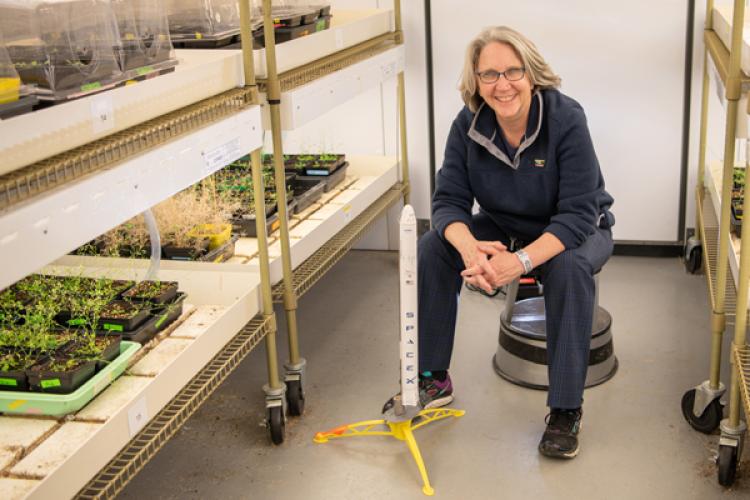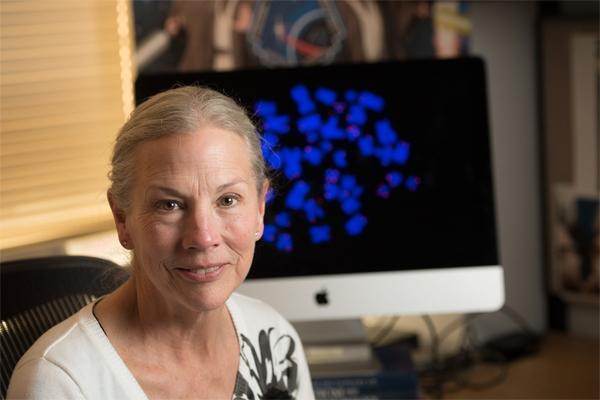
Sarah Wyatt's next experiment on the International Space Station will probe plant telomeres

Ohio University's Sarah Wyatt is teaming up with colleagues from Texas A&M and Colorado State University to research the effect of space radiation on plant telomeres. It will be Wyatt's fifth experiment on the International Space Station.
The three-woman team received one of seven NASA grants announced Nov. 19 for new space biology research that will advance NASA’s understanding of how plants respond, acclimate and adapt to the space environment in support of human space exploration.
Wyatt is an international leader in plant molecular biology with extensive experience in the design and implementation of spaceflight experiments using Arabidopsis. Dorothy Shippen from Texan A&M is a new investigator to NASA known internationally for her pioneering work in establishing Arabidopsis as a model for telomere biology. Susan Bailey of Colorado State University is a renowned radiation biologist who, as one of the NASA Twins Study investigators, first reported changes in telomere length dynamics in astronauts on long-duration missions.
Together they will combine expertise and resources to test the effect of spaceflight on telomere length, telomerase activity and oxidative stress, a connection they have previously noted in preliminary data. Their central hypothesis is that chronic exposure to the space radiation environment elevates intracellular reactive oxygen species, which in turn leads to genome and telomere oxidation, telomerase induction and organellar disruption in space-grown plants.

How the Team Came Together
After her last space experiment, Wyatt set her sights on studying telomeres, which are a region of repetitive DNA sequences at the end of a chromosome that not only protect the ends of chromosomes, they also are an indicator of a cell's health since telomeres become slightly shorter each time a cell divides.
Shippen and Wyatt started teaming up when Wyatt envisioned how to make the most of some "extra" plant material that had flown in space.
Like many in the scientific community, Shippen was intrigued by work in Bailey's lab evaluating telomere length dynamics (changes over time) and persistent DNA damage responses (DDRs; genome instability) in twin astronauts Scott and Mark Kelly. So Shippen inquired with the GeneLab Plant Analytics Working Group if they any had extra plant tissue from a spaceflight.
"Her timing was excellent as the APEX-07 flight samples had just returned to Earth, or at least part of them had," Wyatt said. "Due to an accident on the flight, only 60% of the seedlings returned; the rest had thawed on the International Space Station and were unrecoverable. The experiment was flown again, leaving ‘extra’ flight samples, some of which we sent to Dr. Shippen for telomere-related analyses," said Wyatt, professor of environmental and plant biology in the College of Arts and Sciences at Ohio University.
"Now we are building on exciting preliminary data from the work done in my lab and the Shippen lab. Data gathered from a previous spaceflight and ground experiments shows a greater than 50-fold increase in telomerase enzyme activity but stable telomere length in space flown plants. Importantly, telomerase activity was not substantially elevated under simulated microgravity conditions on the ground, implying that radiation is responsible for telomerase induction," Wyatt added.

How Will Radiation Affect Plants Grown in Space?
Space radiation occurs outside the protection of Earth’s atmosphere and magnetosphere and includes exposure to high-energy protons produced from sporadic solar particle events, as well as chronic exposure to galactic cosmic rays, which consist of electrons and positrons (2%), protons (85%), helium nuclei (12%), and heavier, more densely ionizing and damaging particles known as high-atomic number and energy-charged particles (1%).
The future of long-duration space travel and exploration missions to the moon and Mars will require plants for food production, carbon dioxide removal, oxygen production and water purification. But extended exposure to the extreme environmental factors that accompany spaceflight, which include microgravity and ionizing radiation, have profound and largely unknown health effects on biological systems.
"We have conducted numerous plant experiments in simulated microgravity on the International Space Station. And while radiation exposures induce stress responses in plant systems, we now hope to better understand the mechanisms underlying spaceflight-induced plant stress responses, plant genomic adaptation to spaceflight environments, and long-term plant viability under different space radiation scenarios," said Wyatt, who has extensive experience in the design and implementation of spaceflight experiments using Arabidopsis.
The team's project has three objectives:
- Analyze the influence of the combined stressors associated with spaceflight on plant telomere maintenance dynamics, genome stability and oxidation, and organellar abundance in space-grown Arabidopsis.
- Determine the impacts of low dose, low dose-rate/fractionated schemes of simulated space radiation exposure and establish dose responses for plant telomere maintenance dynamics, genome stability and oxidation, and organellar abundance in ground/Earth grown Arabidopsis.
- Synthesize experimental results and evaluate central hypothesis. The three research teams will synthesize the data gathered from spaceflight and ground fractioned radiation exposure experiments to address the central hypothesis.
"Completion of these objectives will provide a deeper appreciation of genome dynamics elicited by the space radiation environment for crop plants in upcoming space missions," Wyatt said.
